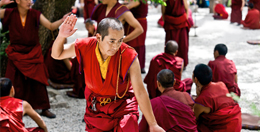Tibetan Khata & Butter Tea
Tibetan Butter Tea
Butter tea, also known as Po Cha or Goor Goor in local Ladakhi terms, is a drink of the Tibetans and some other ethnic groups in southwestern China. It is traditionally made from tea leaves, yak (or sheep) butter, and salt. Drinking Butter Tea is a regular part of Tibetan life. Before work, a Tibetan will typically down several bowlfuls of this tangy beverage. Nomads are said to often drink up to 40 cups of it a day. Since butter is the main ingredient, butter tea is a very warming drink, providing lots of caloric energy and is particularly suited to high altitudes. The butter also helps prevent chapped lips.
Butter Tea is always served to guests. According to the Tibetan custom, butter tea is drunk in separate sips, and after each sip the host refills the bowl to the brim. Thus, the guest never drains his bowl; rather, it is constantly topped up. If the visitor does not wish to drink, the best thing to do is leave the tea untouched until the time comes to leave and then drain the bowl. In this way etiquette is observed and the host will not be offended.
Butter tea is also used for eating tsampa by pouring onto it, or dipping the tsampa into it, and mixing well.
The culture of butter tea was created by the Tibetans over tens of thousands of years during which struggles against harsh natural conditions were gonging on. Butter tea is a necessity in parties of friends-making, festival celebration, farewell and romantics. Additionally, it is reposed with the Tibetan's good wish.
Khata|Hada Presenting in Tibetan Culture
A khatak is a traditional ceremonial scarf, originated from Tibetan culture, it later adopted by the countries (Mongolia, Bhutan, Nepal, some part of Russia and India etc) where Tibetan Buddhism was spread and they too adopted a similar kind of culture.
Khatak has many usage, Khatak are use for birth, wedding, funeral, ceremony etc. It symbolizes purity and compassion. It is usually made of silk. Tibetan khatak are usually white symbolising the pure heart of the giver, though it is quite common to find yellow gold khatak as well. Tibetan and Bhutanese khatak has symbol of eight lucky auspicious signs meaning to bring good luck and fortune. There are also special khatak with five different colors. Mongolian khatak are usually blue, symbolizing the sky.
Khatak can be presented along with incense and other religious items at weddings, funerals, births, graduations, arrivals and departure of guests. The Tibetans commonly give a kind acknowledgment of "Tashi Delek" (meaning good luck) at the time of presenting.
In Mongolia, Khatak are also often tied to ovoos, stupas or special trees and rocks.

.jpg)













